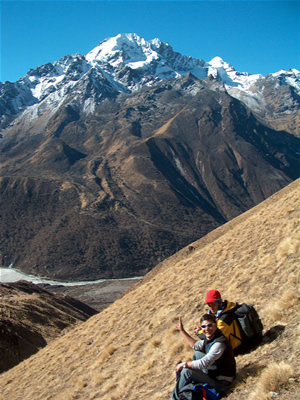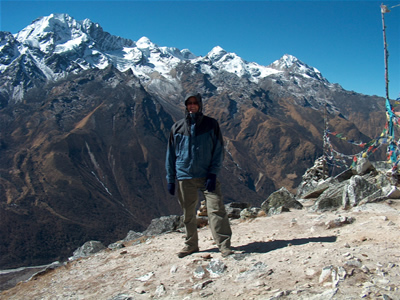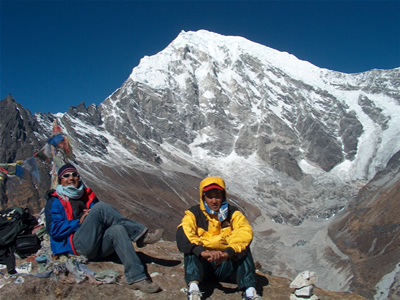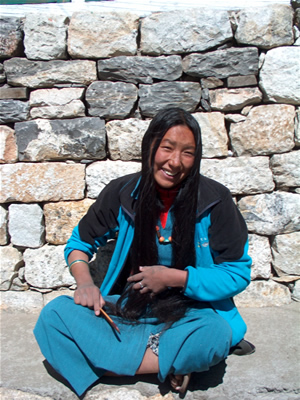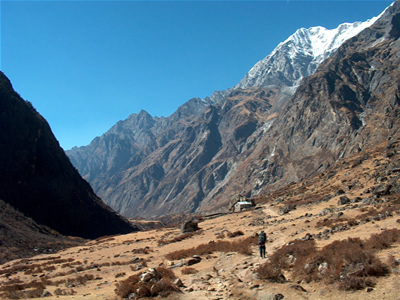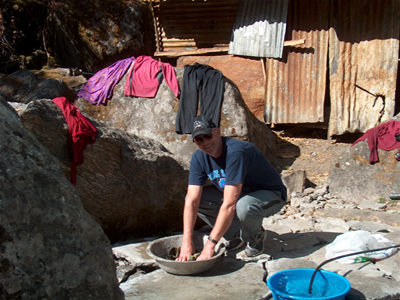Getting High
At 12,800 ft Kyangjin Gompa is the highest village in the Langtang Valley. That means it is the highest lodging available. Since most trekkers in Langtang stay in lodges rather than camp, a lot of them use Kyangjin Gompa as a base for day hikes. There are lots of opportunities to explore further up the valley or to climb to scenic high points that surround it. Our plan for the morning was to climb to the top of Kyangjin Ri. It is really just a big, steep hill but it is 15,659 ft high (4773 meters) and is a spectacular viewpoint. We would descend back to Kyangjin Gompa and our lodge there for lunch, pick up our gear, and hike back down to Langtang Village to stay the night. Since we were descending we figured that we could make the trip down to Langtang in an afternoon even though it had taken us a full day on the way up.
We got up very early and it was definitely cold. I had my usual light breakfast before we started out shortly after dawn. The slopes of Kyangjin Ri rose directly behind our lodge. After a short climb we did a traverse to the right into a gully between Kyangjin Ri and the next ridge over. We continued climbing on a nice trail up the gully that rose to a saddle at the end. But rather than continue all the way to the end Tasi eventually turned left and headed straight up the steep side slope. It was about as steep as it could be and still be hiking. At that altitude it was hard work. Very hard work. And slow work too, at least for me. But considering the altitude I felt good and thought we were making steady progress.
We were traveling light. We left most of our stuff at the lodge and only took two day packs. Tasi had one with stuff for himself and Khim in his. I had my pack with some warm clothes, my camera, snack foods and a water bottle. Since Khim wasn't carrying a pack he offered to take mine. I didn't like the idea hiking along while someone else was carrying my pack. That was really kind of silly though since Khim carried my duffel bag on the trail every day. Tasi pushed me on it and I reluctantly agreed. I was the slowest of the three us. It didn't make sense for me to be loaded down which would just slow me down even more while Khim was held up waiting for me. So I wasn't proud and gave him my pack.
The climb up the side of the gully was really hard work took a long time. Eventually we came out onto the main ridge. By then we were only a few hundred feet below the summit and climbing the ridge line wasn't as steep. Then we were on the summit. At 15,659 ft we were more than a thousand feet higher than any mountain in the continental United States. Mt. Whitney, the highest mountain in the US, is only 14,494 ft. I have only been that high a few times in my life. So I felt pretty good about reaching that height. I didn't have much trouble with the altitude either. Not bad for an old man.
It was a nice day and I was hiking all morning in just a long sleeve shirt again. But when we reached the top there was a strong wind. Since we were just sitting rather than moving I put on my shell and a warm hat while we were on the summit. I spent most of the time taking pictures. There were beautiful views in every direction. Close by was the huge cirque formed by Langtang Lirung and Langtang II. It was filled with the Langtang Glacier which started on the east face of Langtang Lirung and descended almost to Kyangjin Gompa. Our ridge formed the east side of the cirque but was by far the lowest point. To the north was Yalu Peak, a fairly easy snow climb that is on the short list of climbs that you can do with just a trekking permit rather than a mountaineering permit (which costs thousands of dollars). To the east were the spectacular peaks of Gangchempo and Langshisa Ri. But they weren't conducive to good photographs this early in the morning with the sun still in the eastern sky so you'll just have to take my word for it. To the south was a group of peaks centered on Naya Kanga that formed the southern wall of the Langtang Valley. A high pass, the Kanga La, went through those peaks. It is a difficult alternative route to the Helambu region but is only open for a few months in summer. In winter when we were here itwas buried in snow and was impassible.
The time on the summit was magical, with perfect weather and wonderful scenery all around. Eventually though it was time to go back down. Instead of taking the same steep slope that we had climbed, we continued along the ridge past the summit to its lowest point at the head of our original gully. There was a rough trail that led down and we followed it all the way back to the lodge. It was much easier, although going down certainly helped.
By the time I got back to the lodge I was really hungry. I ordered a big plate of noodles for lunch and they really tasted good. It was a chance to eat heartily without guilt. After a workout like we had in the morning it was my duty to eat lots of carbohydrates. I had to make sure that I had lots of energy for the long hike coming up in the afternoon.
After lunch I was talking to one of the ladies who worked at the lodge. She had very long hair which she had just washed and was combing out. At that altitude and in that cold it seemed like a lot of work to look after. I was glad for my buzz cut. I had some family photos with me and I showed her a picture of Sandy. I explained that my wife did not have long hair like her. She was quite fascinated. She agreed that short hair would be much easier and said that she was envious.
She agreed to let me take a photograph of her and I promised to print it as soon as I got back to Singapore and send one to her. Cameras and pictures are still somewhat of a novelty in such a remote region.
Although it took us a day to hike up from Langtang village, we were able to hike down in just an afternoon. Going downhill and better acclimatization really helped us go faster. We stayed at the same lodge as two nights before. I was looking forward to a shower but learned that after my shower on our previous visit the pipes had frozen overnight and been damaged. So no showers. Oh well. I didn't really want to have standing water in the bathroom all night anyway.
At dinner that night we found out more about the strike the Brits had told me about the other day. There had been a terrible accident the week before on the road from Pokhara to Kathmandu. Two young children were hit by a bus and killed. I had taken a bus on that route after my Annapurna trek last fall. Seeing how traffic zips through villages and how kids run through the streets, I am surprised that many more accidents don't happen. The parents of the dead children tried to get the bus company to pay damages (sounds kind of creepy to me) and they had refused, so the local representative to parliament had organized a strike. He chose to close the road to Langtang because it is the only road in and out of the region and because there is an important mine that is dependent on the road. Only a few vehicles, such as the bus with the Brits, had made it through the day after I went through. Since then the road had been completely closed. So no one could get to the trailhead for Langtang. That explained why we had seen almost no trekkers the past two days. I was the only trekker at the lodge that night - I had the guest building to myself.
The next day was an easy hike down to Lama Hotel. What took us a day to ascend was again only a half day going down. We reached our destination by lunch time. There was not a better spot to stay within an afternoon's walk so we stopped for the day. I took advantage of the free afternoon to take a shower (overdue) and to do my laundry. Then with my laundry hanging out in the sun to dry I sat down to read. One of the horses that the lodge keepers owned tried to steal a tshirt from the line but I stopped him.
Because of the strike I was the only trekker in the lodge. In fact, I was the only trekker in all six of the lodges at Lama Hotel. A lady who worked at one of the other lodges came by in the afternoon to ask if I had seen other trekkers on the trail. Unfortunately I had to tell her that we hadn't seen another party all day and she was clearly disappointed. This was a real hardship for the local people. They have a tough time making a living as it is and this is normally a slow season. But now because of the strike there were no trekkers at all and no business for them.
At dinner that night, Tasi brought my dessert by as soon as I had ordered my main course. Every night on the trek I always got my main meal from the lodge. But for some reason I was always served a dessert item that we carried along with us - usually fresh or canned fruit. Actually I usually welcomed it after a Nepali dinner heavy on spices and garlic. But last night Tasi had canned baby corn instead of fruit. I don't really care for baby corn but didn't want to say so after Khim had carried it for many days. So last night I ducked. I had been "too full for dessert". Tasi got wise to me and brought dessert out right away tonight without even asking. But I lucked out because he was gone when the lodge keeper came in to clear away my plate from dinner. I told him the baby corn was good, that I hadn't eaten any, and that he could take it to the kitchen and give it to someone else. The Nepalis usually polished off any leftovers from every meal. Nothing goes to waste in Nepal. But he just looked at it strangely and said "Hose".
I didn't understand so I asked him about it again. He repeated "Hose". Ok. I guess he doesn't like it either if he has to hose it down the drain. But the mystery was solved a few minutes later when I went outside to get water to brush my teeth. There was the same "hose" that had tried to steal my tshirt this afternoon and he was eating my veggies. Nothing goes to waste in Nepal.
Down to only 8000 ft again it seemed really warm that night compared to the high country where we had spent the last few days. The first part of the trek was done. Tomorrow we would leave Langtang and head into Gosaikund Lakes/Helambu.
